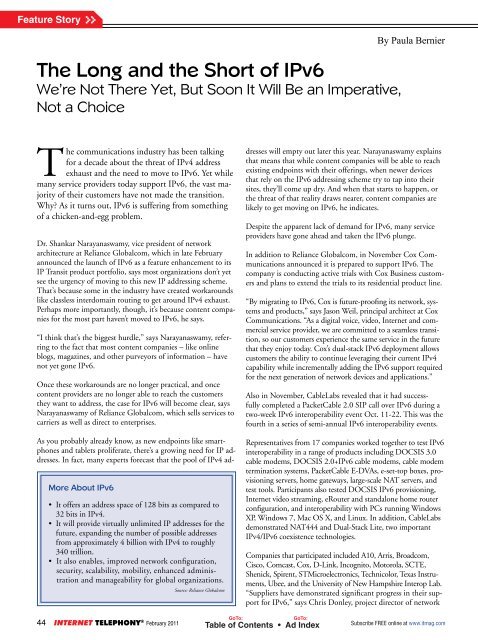service provider news - TMC's Digital Magazine Issues
service provider news - TMC's Digital Magazine Issues
service provider news - TMC's Digital Magazine Issues
- No tags were found...
You also want an ePaper? Increase the reach of your titles
YUMPU automatically turns print PDFs into web optimized ePapers that Google loves.
Feature StoryThe Long and the Short of IPv6We’re Not There Yet, But Soon It Will Be an Imperative,Not a ChoiceBy Paula BernierThe communications industry has been talkingfor a decade about the threat of IPv4 addressexhaust and the need to move to IPv6. Yet whilemany <strong>service</strong> <strong>provider</strong>s today support IPv6, the vast majorityof their customers have not made the transition.Why? As it turns out, IPv6 is suffering from somethingof a chicken-and-egg problem.Dr. Shankar Narayanaswamy, vice president of networkarchitecture at Reliance Globalcom, which in late Februaryannounced the launch of IPv6 as a feature enhancement to itsIP Transit product portfolio, says most organizations don’t yetsee the urgency of moving to this new IP addressing scheme.That’s because some in the industry have created workaroundslike classless interdomain routing to get around IPv4 exhaust.Perhaps more importantly, though, it’s because content companiesfor the most part haven’t moved to IPv6, he says.“I think that’s the biggest hurdle,” says Narayanaswamy, referringto the fact that most content companies – like onlineblogs, magazines, and other purveyors of information – havenot yet gone IPv6.Once these workarounds are no longer practical, and oncecontent <strong>provider</strong>s are no longer able to reach the customersthey want to address, the case for IPv6 will become clear, saysNarayanaswamy of Reliance Globalcom, which sells <strong>service</strong>s tocarriers as well as direct to enterprises.More About IPv6• It offers an address space of 128 bits as compared to32 bits in IPv4.• It will provide virtually unlimited IP addresses for thefuture, expanding the number of possible addressesfrom approximately 4 billion with IPv4 to roughly340 trillion.• It also enables, improved network configuration,security, scalability, mobility, enhanced administrationand manageability for global organizations.Source: Reliance GlobalcomAs you probably already know, as new endpoints like smartphonesand tablets proliferate, there’s a growing need for IP addresses.In fact, many experts forecast that the pool of IPv4 addresseswill empty out later this year. Narayanaswamy explainsthat means that while content companies will be able to reachexisting endpoints with their offerings, when newer devicesthat rely on the IPv6 addressing scheme try to tap into theirsites, they’ll come up dry. And when that starts to happen, orthe threat of that reality draws nearer, content companies arelikely to get moving on IPv6, he indicates.Despite the apparent lack of demand for IPv6, many <strong>service</strong><strong>provider</strong>s have gone ahead and taken the IPv6 plunge.In addition to Reliance Globalcom, in November Cox Communicationsannounced it is prepared to support IPv6. Thecompany is conducting active trials with Cox Business customersand plans to extend the trials to its residential product line.“By migrating to IPv6, Cox is future-proofing its network, systemsand products,” says Jason Weil, principal architect at CoxCommunications. “As a digital voice, video, Internet and commercial<strong>service</strong> <strong>provider</strong>, we are committed to a seamless transition,so our customers experience the same <strong>service</strong> in the futurethat they enjoy today. Cox’s dual-stack IPv6 deployment allowscustomers the ability to continue leveraging their current IPv4capability while incrementally adding the IPv6 support requiredfor the next generation of network devices and applications.”Also in November, CableLabs revealed that it had successfullycompleted a PacketCable 2.0 SIP call over IPv6 during atwo-week IPv6 interoperability event Oct. 11-22. This was thefourth in a series of semi-annual IPv6 interoperability events.Representatives from 17 companies worked together to test IPv6interoperability in a range of products including DOCSIS 3.0cable modems, DOCSIS 2.0+IPv6 cable modems, cable modemtermination systems, PacketCable E-DVAs, e-set-top boxes, provisioningservers, home gateways, large-scale NAT servers, andtest tools. Participants also tested DOCSIS IPv6 provisioning,Internet video streaming, eRouter and standalone home routerconfiguration, and interoperability with PCs running WindowsXP, Windows 7, Mac OS X, and Linux. In addition, CableLabsdemonstrated NAT444 and Dual-Stack Lite, two importantIPv4/IPv6 coexistence technologies.Companies that participated included A10, Arris, Broadcom,Cisco, Comcast, Cox, D-Link, Incognito, Motorola, SCTE,Shenick, Spirent, STMicroelectronics, Technicolor, Texas Instruments,Ubee, and the University of New Hampshire Interop Lab.“Suppliers have demonstrated significant progress in their supportfor IPv6,” says Chris Donley, project director of networkGoTo:44 INTERNET TELEPHONY ® February 2011 Table of Contents • Ad IndexSubscribe FREE online at www.itmag.comGoTo:









